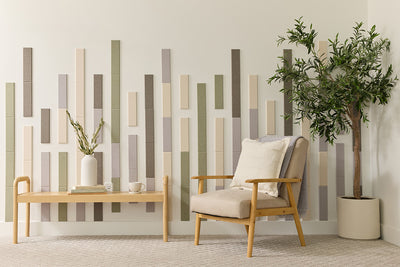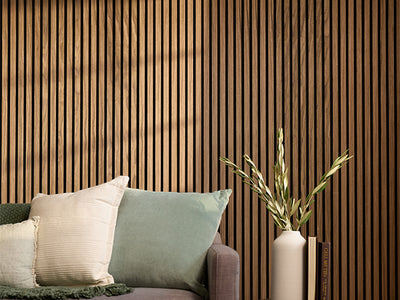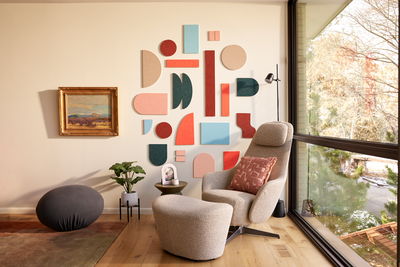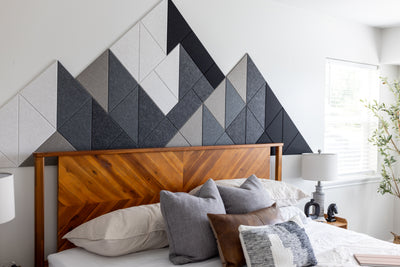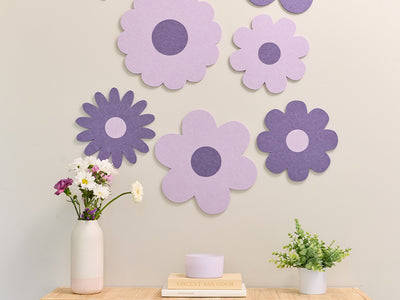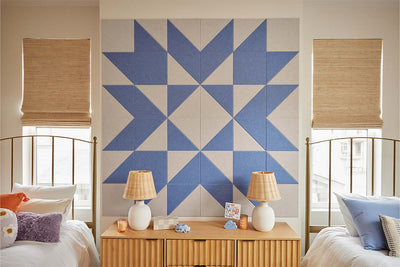Acoustic Room Treatments: From DIY to Pro

A room with bad acoustics can make everything from having a conversation to listening to music less enjoyable than it should be. With proper acoustic treatment, a space can dampen unwanted noise and enhance the sound, allowing spaces to be quieter and friendlier to the sound you do want.
However, acoustically treating a room to dampen sound is not the same as soundproofing. In this blog, we'll unpack the nuances that differentiate these two concepts and guide you through a variety of strategies to acoustically enhance any space, from straightforward DIY projects to more sophisticated, professional approaches.
What Is Acoustic Treatment and Why it Matters
There is a common misconception that acoustically treating a room is the same as soundproofing, which is simply not true. The distinction between the two is crucial when considering the acoustic treatment of a space. So here's the breakdown: Acoustic treatment focuses on improving the quality of sound within a room by managing sound reflections and absorbing unwanted noise, rather than blocking sound from entering or leaving a space, which is the goal of soundproofing.
In other words, if you want a quieter space or a space friendlier to sound so that your music and movies sound better, you'll want to do an acoustic treatment. If you want to have a professional recording studio, a panic room, or a meditation space, soundproofing might be the better, albeit pricier, option.
The Essence of Acoustic Treatment
At its core, acoustic treatment aims to enhance the auditory experience within a room. It deals with issues, such as echo, reverberation, and standing waves, which can distort sound clarity and fidelity. By carefully designing and applying treatment solutions, one can significantly improve speech intelligibility, reduce sound clutter, and ensure that music or any audio content is heard as intended, with minimal coloration or distortion. Regardless of whether or not you're an audiophile, a room with better acoustics can still be beneficial for dampening unwanted noise and having in-person conversations and virtual meetings.
How It Dampens Sound
- Absorption: This is the process of reducing the energy of sound waves. Absorptive materials, like acoustic foam or felt acoustic tiles, convert sound energy into a small amount of heat, thus reducing the overall sound levels in the room. This is particularly effective for mid to high-frequency sounds, helping to clear up speech and reduce harshness in music.
- Diffusion: Diffusers scatter sound waves, spreading them out in multiple directions rather than allowing them to bounce directly back into the room. This breaks up room echo, creating a more even sound distribution. Diffusion helps maintain a lively sound environment without the drawbacks of direct reflections, making it essential for spaces used for music recording or listening.
- Bass Trapping: Low-frequency sounds have longer wavelengths and are harder to manage. Bass traps are designed to absorb these low frequencies, typically positioned in corners where bass tends to build up. By tackling the low-end, bass traps prevent muddiness and ensure a clearer, more balanced sound.
Enhanced Sound Quality, Not Silence
Unlike soundproofing, which seeks to create a barrier against sound transmission, acoustic treatment is about refining the sound that exists within a room. It's about controlling, not eliminating, sound to create an acoustically pleasing environment that enhances music, films, and conversation.

DIY Acoustic Treatment Solution: Textile Wall Art
Despite what the film "Hustle & Flow" shows, stapling egg cartons to your wall is not an effective way to treat a room for sound. Covering walls and doors with blankets is not effective either unless they're thick, soundproofing blankets, which can be pricey.
One of the simplest and most cost-effective ways to acoustically treat a room is to use thick, soft materials that absorb sound. Hanging textile wall art, heavy drapes, or fabric wall hangings, can serve both aesthetic and functional purposes by dampening sound reflections. Thick rugs work wonders as well, and even furniture can play a role. This is because soft materials absorb sound waves, reducing echo and reverberation.
Recording Studio Acoustic Treatment Solution: Bass Traps and Diffusers
For those looking to invest more seriously in acoustic treatment, professional-grade bass traps and diffusers are the next step. Bass traps are placed in corners to absorb low-frequency sounds, while diffusers scatter high-frequency sounds, preventing echoes and ensuring sound clarity.
Addressing both low and high frequencies, this combination tackles a wide range of acoustic issues, from standing waves to flutter echoes, making it ideal for recording studios and home theaters. Yet, if your goal is to treat a living space or office, bass traps and diffusers may not cut it.

All-Around Acoustic Treatment Solution: Felt Acoustic Tiles from Felt Right
Like foam acoustic panels, felt acoustic tiles can be placed on walls to absorb sound effectively. The advantage of felt acoustic tiles is their aesthetic appeal, allowing for custom designs that complement any room decor. Felt acoustic tiles from Felt Right come in dozens of shapes, colors, and sizes, with pre-made patterns that can transform a drab living room or office into a space people actually want to be in. Easy to install, they're perfect for creating an accent wall that also serves to improve the room's acoustics.
Felt may not seem like the ideal material for sound absorption, due to its prevalence in the clothing and furniture industries, but the material is perfectly suited for the role because of the way it's made. Felt is an excellent material for absorbing mid to high-frequency sound waves, making these tiles ideal for reducing unwanted noise and echo in a room.

Mixed Approach Acoustic Treatment Solution: Bookshelves and Plants
A practical and decorative way to add acoustic treatment is through strategically placed bookshelves and plants. Filled bookshelves can absorb and diffuse sound, while plants can help dampen noise levels, especially in larger rooms. This approach adds to the room's aesthetic while providing a functional solution to manage sound reflections and absorption without the need for professional installation.

Felt Right — Acoustic Sound Treatment Done Right
From the tactile simplicity of DIY textile art to the nuanced science of professional bass traps and diffusers, the journey of acoustic enhancement is as diverse as it is rewarding. Incorporating solutions like the aesthetically pleasing felt acoustic tiles from Felt Right, or the organic approach of bookshelves and plants, shows that improving a room’s acoustics can also enrich its visual and functional appeal.
Shop our felt acoustic tiles today to improve the acoustics of your favorite spaces.

